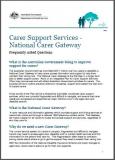Frequently Asked Questions – National Carer Gateway
Q. What is the Australian Government doing to improve support for carers?
A. The Australian Government has committed $33.7 million over four years to establish a National Carer Gateway to help carers access information and support to help them maintain their caring role. The National Carer Gateway is the first step in a longer term plan to better support carers. Work on an Integrated Plan for Carer Support Services (Plan) has commenced and will reflect Australian Government priorities for carers. The purpose will be to outline practical actions to recognise, support and sustain the vital work of unpaid carers.
A key priority of the Plan will be to streamline and better coordinate carer support services, which are currently fragmented and difficult to navigate, and ensure that carer needs are recognised and supported as major reforms occur in the aged care and disability sectors.
Q. What is the National Carer Gateway?
A. A carer resource and information gateway which provides support and linking services to carers both online and through a national 1800 telephone contact centre. This Gateway will make it easier for all carers to locate and access support and services, regardless of who they care for.
Q. Why do we need a new Carer Gateway?
A. The current service system for carers is complex, fragmented and difficult to navigate. Carers may need to access aged care, disability and/ or mental health services and find information for the person they care for. This fragmentation often leads to confusion among carers about where to go to get the support they need to sustain their caring role.
With the introduction of the National Disability Insurance Scheme and major changes to aged care, carers need a place to go for their own supports.
Q. When will the National Carer Gateway commence operation?
A. Commencing from December 2015, the National Carer Gateway will provide a nationally identifiable place for all carers to go for information, support and linking to services.
Q. Will all carers be supported through the National Carer Gateway?
A. The National Carer Gateway will be the front door for Australia’s 2.7 million carers and will provide information and support for all carers, including younger carers, older carers, working carers, Aboriginal and Torres Strait Islander carers and carers from culturally and linguistically diverse backgrounds.
Q. How can we ensure that the National Carer Gateway will meet the needs of carers?
A. To support the development of the National Carer Gateway, an Expert Advisory Group will be established, with membership including representatives from services providers, peak bodies and individuals who have carer-specific expertise.
Q. What does the National Carer Gateway mean for carers receiving existing services?
A. Funding for most Commonwealth carer programs have been extended until 30 June 2017. This extension will ensure continued provision of carer support services as the Plan is designed.
The Plan will ensure there are carer specific services for carers, and it will link carers with aged care services, disability and mental health service systems.
Q. Why is there a new 1800 number being created?
A. Carers are currently searching for support and services through a number of often confusing pathways across the disability, community mental health and aged care sectors.
The new 1800 number will provide carers with a place to go for carer-specific information and support regardless of the need or the age of the person they care for.
Q. How will the new 1800 number be different to the current Commonwealth Respite and Carelink Centres (CRCCs) and carer support service numbers?
A. The new 1800 number will be the first step in providing carers with a nationally consistent experience in accessing information and links to services. Carers can expect information about programs and interfaces with the National Disability Insurance Scheme, My Aged Care and the health sector, as well as information about eligibility and advice on other actions carers may find helpful to sustain them in their caring role.
Q. What does the National Carer Gateway mean for the existing service providers?
A. Current arrangements for existing service providers will continue until the Plan is designed for Government’s consideration.
The National Carer Gateway will be the front door to existing services for all carers, regardless of who they care for, and will provide quick and relevant information about the supports and services available to them. It will take pressure off services so they can consider carers with complex needs.
Co-design work will be undertaken with the sector over the next 6 months to determine how the National Carer Gateway will interact with the existing service system, and on the design of the Plan.
Q. How will the National Carer Gateway interface with My Aged Care, Commonwealth Home Support Programme and the National Disability Insurance Scheme?
A. To deliver the best possible service, the National Carer Gateway will be designed to link with My Aged Care, the new Commonwealth Home Support Programme and National Disability Insurance Agency.
Q. Why are all DSS-funded carer services being consolidated?
A. Currently the management of carer services funded by DSS sit within several areas of responsibility including disability, mental health and aged care.
From 1 July 2015, all carer programs (except planned respite) will be consolidated into one carer policy area within DSS. This will ensure a single line of focus for carer supports to provide a more cohesive approach to the provision of carer support.
Q. Why is planned respite not part of this consolidation?
A. As planned respite is provided primarily in respect of the care recipient, it will remain within its existing service system (e.g. disability and aged care). To ensure carers have continued access to emergency and short term respite, funding agreements for the 54 Commonwealth Respite and Carelink Centres (CRCCs), who currently provide these services nationally, have been extended to 30 June 2017.
Last updated:

